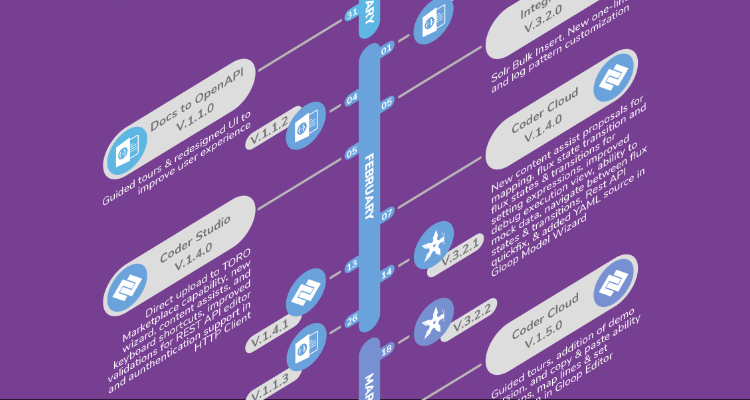UPDATE: 9/9/19 References to Toro Integrate, Toro Coder and Toro Coder Cloud refer to pre-release versions of Martini Desktop and Martini Online.
Wayne Bucklar interviews David Brown, Founder & CEO of Toro in which Brown explains what drove him to create Toro and his mission to create accessible enterprise software. In this interview David Brown talks about his vision for Toro and how he is making that vision a reality with the launch of Toro Integrate.
Wayne Bucklar: Joining today on the program is David Brown. David is the CEO and founder of Toro, it’s enterprise software let’s talk about what it does. David welcome to the program.
David Brown: Thanks Wayne.
Wayne: David I understand you just recently launched Toro, tell us what this is and what does.
David: Well, Toro has been a vision several years in the making actually. We started with this concept when we were deploying enterprise class software ourselves in an online retail venture that we had at the time, my business partner and I. Our business grew very very quickly, from 300 orders a day in the first month to 3,000 orders a day within a few years. And so we had to scale our systems pretty quickly to deal with that growth. Now the business become more complex in terms of having of hundreds of thousands product online, with different brands, different currencies, different countries, splitting orders over different warehouses and real time fulfillment options and currencies and all these complexities. And yet these complexities aren’t issues that the small businesses are normally built or equipped to deal with and so as a result, we were in a software development phase ourselves, we built all our systems and it is very very well in getting our business started but it wasn’t keeping up with the phase of our growth. And so we went to market and we wanted to a license a third party software to facilitate our growth and get us really best in class in what we were doing. And so that meant we had to approach all the enterprise software vendors for e-commerce and middleware - the 2 major applications we were looking for. And to be honest the experience wasn’t great. The experience is what lead us to where we are today, back into this space of developing enterprise applications ourselves, because we found that the industry lacked transparency as to the deliverables of what we’re going to get. And so the project consumed a few years of my life, it was literally a full-time job for a few years and all of the business disruption that meant for the business and all of the stakeholders in the business and having the CEO occupied with such an immense project. It went several times over budget, the scope and specifications seemed to come quite elastic during the process and flexible and things changed. And at the end of the project, we ended up getting tied into system vendors and/or systems integrators which have done customizations to the solution which effectively create a vendor lock in and door lock in to the systems integrator themselves. So others found the whole experience less than satisfactory, the end result was we didn’t end up with the kind of scalable solution that we were looking for, so is our requirements, but I just felt like the experience it could be done at better way. And so the vision for Toro was born out of that experience and it was Toro’s vision to create accessible enterprise software and that means accessible to any size business, whether it be a small business going to the growing pains like we experienced, a mid-sized business which already house-laws issues but needs to do more self-assessment during the enterprise software procurement process or if you’re in the Fortune 500 and you’re already dealing with these immense issues, which would be scalable to all of those business segments and it should be accessible.
Wayne: David, that experience you had at dealing with the established players in the market. When I look around at the web at their products, the websites all look right in shiny and everything seems to be there. You said it lacked transparency?
David: It’s true, some of the websites looked shiny and in fact from an end user’s perspective it may be very very difficult to differentiate between them because they all claim to do largely the same thing when in fact, they all pretty much can’t to be honest. So most enterprise class solutions, solving the same problem sets, it’s really what matters is the approach about how they solved which problem sets. It’s very difficult to establish that from a feature list, so if you’re looking at website and has check boxes, Yes we have this feature, this feature and this feature and even if you’re looking at a product comparison, even if it is an independent product comparison, and you still viewing check boxes, it still doesn’t really give you the full picture as to how that company solves that problem. So because the end result may be the same, but the way you go about solving math problem can be very very different. So when I talk about accessibility and enterprise software applications and when I talk about transparency, I’m really talking about making all of that transparent and visible to the customer. Making them realize, “What’s it going to cost me to get into this application? What can I expect from a build? What can I expect from a deployment? What can I expect from management of deployment?” All of these things is Toro’s philosophy, it’s providing transparency and accessibility in this market place. I’ll give you another example, the cost of enterprise software is clearly not transparent. On most of those websites which you’re referring, although they may looked glossy, getting price discovery is very very difficult. Most of them will have a “Contact us for pricing’ link and so what that really means is, is either a.) we’re embarrassed to tell you what our prices are or b.) we’re going to find out what your budget is and we’ll charge you what we think you can bare.
Wayne: And I know that in your website before we came on air today, there is a table there and I think it was Invocations per Thousand Enterprise.
David: Sure. It is actually on my homepage (laughs). There’s a pricing link in the top navigation bar and there’s full data pricing provided on the homepage as well. There’s complete feature list and exactly what you get on each plan as well. In terms of making accessible, prices was obviously key factors, not the only factor which we consider accessibility, but it has to be accessible to all of those business groups I was talking about before, from those small businesses to enterprise class customers. So what you were talking about in terms that you’ve mentioned, you saw the number of invokes per month, is on our SaaS space future deployment model if you want to deploy your solution in the cloud and it’s pay per use. So if you’re not using it much, you don’t pay much (laughs). If you’re using it more, then you’ll pay more. So it’s fair, transparent, easy to understand and it gets to the point where you don’t want a pay per use so much anymore, you just want unlimited invokes and you can do that as well and that’s all about being transparent on the website.
Wayne: And David.I presume you’re helping to build a community of users around this platform and develop that pool of expertise around the globe.
David: We do. I think this is a key as well, so when we’re building the enterprise applications in our company years ago, we really felt like we were building ...which should’ve worried existed. We were building modules which we were told “Why do we need to build this? Surely it’s been done before.” And I said “Well it’s a framework, so what you get is an online framework which you can build upon and yes, although we may have done that for previous customers we can’t release that code and blah blah blah and so you end up paying for that build again.” Whereas our approach is that from day 1 we have a marketplace where the community can share and collaborate on code whether that be a complete application or a module of application right down to a widget or a connector. All of these things, we can contribute ourselves as the publisher on some of these modules and so the marketplace is full of connectors for various APIs, there’s some apps which we built as well, some case studies and templates for connecting from various APIs but the community can contribute as well. And so to foster that collaboration we also have a community Q&A platform where they can discuss issues and get assistance on development assistance and help and of course we monitor that community forum as well and foster the collaboration between community members.
Wayne: David it does sound like it has a potential to be one of those releases that disrupts an existing chain and does it on the basis as you say of transparency and price. For people who are interested, how do they get hold of you?
David: Well the first port of course should really be our website which is Toro.io and on our website there’s all of the information regarding the product that more importantly you can try the product yourself. Again this is not necessarily available and transparent with enterprise applications today is that unless they have a SaaS based business model in fact even some that do if you want to trial that SaaS solution you have to apply. With ours, anyone can do it, you can download product to your own machine, you can get an online free trial that has no gatekeeper, it’s set up within seconds, it’s all automatically provisioned, it’s a self assessment model. So particularly these small to medium sized business they don’t have the resources for the large procurement processes that large corporates go through with an RFP process and the like, they do much more self assessment, they have their own team members or perhaps a consultant taking a look for the products in the marketplace and creating a shortlist as to the applications which are going to be suitable for purpose. So we try and provide as much information on our website, all of the documentation is available for free, you can even chat with us in realtime for free directly within the product itself. We are that accessible to our customer-base and we make the product as well as contacting us as accessible as possible.
Wayne: David, thank you for sharing that with us today, it’s been a pleasure having you on. David Brown is the CEO and founder of toro.io, an enterprise grade platform.




